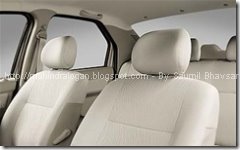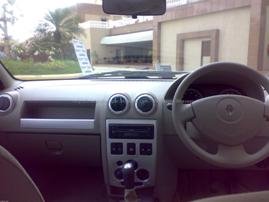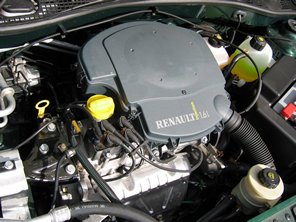Is it Worth Waiting for the Logan!?
Logan is the European face of low cost manufacturing which knocks out many global manufacturers, now heads to India-paradise of low cost manufacturing. Renault is now cloning its success to Nashik-where 5 lakh cars is going to be produced through a joint venture between Mahindra and Mahindra (M&M) and Renault. The car is sold across three continents i.e. European, African and Asian and in 42 countries (the car is not offered in US).Despite the low cost 5000 euros (Rs3,00,000) its quality nothing sort of a good car from other manufacturers. Toyota and GM is drawing methods to produce a low cost vehicle that could challenge the Logan.
Engine and Powertrain:
The car will be made available with three different engine options and in as many as eleven variants, to compete from indigo to fiesta, from Verna to aveo. The company is looking at launching two petrol engines for the car — a 75bhp, 1.4-litre and a 105bhp, 1.6-litre and a 70bhp, 1.5-litre common rail direct ignition (CRDi) K9K diesel engine. It comes with second-generation common-rail injection and a low-inertia turbo. Power output is a modest 70bhp, similar to the Tata Indigo, but the torque of 16.3kgm is (higher than the Tata indigo) with 85% of peak torque available between 1,500 and 3,500rpm, the 70hp 1.5 dCi engine delivers lively acceleration that will meet your expectations. Gear ratio is good enough to exploit the torque of the engine i.e. you don’t need often switch gears. Supercharged by a low-inertia turbocharger to reduce the response time, it combines comfort and driving flexibility. Since a large amount of soundproofing (to preserve the low cost) was omitted, road vibrations and engine sound and wind noise are noticeable for the passengers. The engines are specially prepared to handle lower quality fuel, preserving the fuel economy and pollution levels. Combined with its 50-litre tank, the model’s low fuel consumption gives it a basic range of over 1,000 kilometers The Logan 1.5 dCi accelerates from 0 to 100kph in just 15 seconds quicker than fiesta and indigo. Fuel consumption is very frugal. Deduce the figure by 25% for India u will happy to ride it against Indigo and Verna. Fiesta cannot match its low cost despite equable mileage.
Mileage figures in Europe
1.4l(pet) 1.6l(pet) 1.5l(die)14.7kpl 13.7kpl 21.3kpl
Price band
Logan combines keen pricing with low running cost. It requires servicing gasoline engines for every 30000km and 20000km for diesel engines and Renault provides generous warranty (3yr or 100000km warranty). The petrol Logan is estimated to be priced at between Rs 4.5 and Rs 4.8 lakh (base model) while the diesel variants will be priced around Rs 5.5 lakh.
Design and comfort:
The Logan is based on the B platform on which third generation Renault cars are built. Logan designer Kenneth Melville (the man who designed the Mercedes SLK) told Business Week, the original design brief for the auto was a “value-for-money car with a lot of space and the stately look of a sedan.” Certainly Logan serves the purpose.
Exteriors:
In order to make maximum savings on production costs and recycle components and technical solutions already in stock, the car comes with a flatter windscreen than usual, a single body shell (to save on welding), rear-view mirrors are symmetrical and can be used on either sides of the car and a dashboard moulded in one piece. The rear lamp clusters, set at an angle, smooth out the car’s structured edges. The Indian Logan is all set to get a different grille and a Renault logo. It will also come with new lights and an entirely body-coloured nose. The aerodynamic drag coefficient is 0.360.Ground clearance is 155mm where Mahindra&Mahindra and Renault have to work out for the Indian roads. Logan suspension is said to be soft and strong, and the chassis sits visibly higher than most other cars help it to negotiate dirt roads and potholes and is appreciated by many auto analysts, but the real test will come when the car hits the Indian road.
Interiors:
With a record wheelbase of 2630mm against indigo (2450mm), Verna (2500mm), Fiesta (2486mm) it is more spacious and it can be compared with what tata calls indigo limousine(Indigo XL pricing almost 7 lakh).The Logan’s interior space was designed for countries where it is common for whole families to pile into one car! So there are 5 proper seats and a very large boot with a capacity of 510 litres, offering best-in-class value. Three very tall passengers (over 1900 m) can sit comfortably in the back. The width of the seats (1,420 mm), foot room (420 mm) is generous, and there is 185 mm of knee room. The adjustable steering column and seat and with a cabin length of 1685mm (you no longer need to adjust for the driver).Air conditioning takes between 3 to 10 minutes maximum to reach the desired temperature and is powerful enough to lower temperature even from 40C. The absence of a boot release means you have to use the key each time you want to open the boot. This certainly is taking cost cutting a bit too far
Logan is the European face of low cost manufacturing which knocks out many global manufacturers, now heads to India-paradise of low cost manufacturing. Renault is now cloning its success to Nashik-where 5 lakh cars(that number could increase by 3lakh if Nissan decides to join the duo) is going to be produced through a joint venture between Mahindra and Mahindra (M&M) and Renault. The car is sold across three continents i.e. European, African and Asian and in 42 countries (the car is not offered in US).Despite the low cost 5000 euros (Rs3,00,000) its quality nothing sort of a good car from other manufacturers. Toyota and GM is drawing methods to produce a low cost vehicle that could challenge the Logan.
Safety and special features:
The Logan was the subject of intensive work regarding safety. The vehicle’s structure has deformation zones and is designed to disperse the kinetic energy of an impact. The dashboard is also of major importance in providing protection in the event of frontal impact. Its honeycomb structure, made of highly absorbent polypropylene, reduces the risk of knee injury in the event of an impact, while the structure of the seats keeps the pelvis in an appropriate position. Despite the low cost Renault’s use of digital simulation makes the car fetch an overall rating of 9 EuroNcap. Airbags, ABS (antilock braking system), child seat, EBD (electronic brake distribution) and for other features we have to wait till the launch of the car probably on 4th April!!




